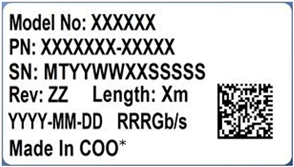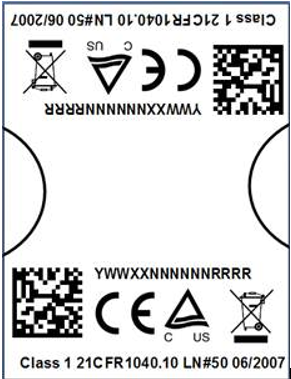Specifications
Absolute maximum ratings are those beyond which damage to the device may occur.
Between the operational specifications and absolute maximum ratings, prolonged operation is not intended and permanent device degradation may occur.
|
Parameter |
Min |
Max |
Units |
|
Supply voltage |
-0.3 |
3.6 |
V |
|
Data input voltage |
-0.5 |
Vcc+0.3 |
V |
|
Control input voltage |
-0.3 |
Vcc+0.3 |
V |
|
Parameter |
Min |
Typ |
Max |
Units |
|
Storage temperature |
-10 |
-- |
70 |
°C |
|
Operating case temperature |
0 |
--- |
70 |
°C |
|
Operating relative humidity |
0 |
--- |
85 |
% |
This section shows the range of values for normal operation.
|
Parameter |
Min |
Typ |
Max |
Units |
|
Supply voltage (Vcc) |
3.15 |
3.3 |
3.45 |
V |
|
Power consumption |
--- |
0.8 |
1 |
W |
|
Supply noise tolerance |
66 |
--- |
--- |
mV |
|
Parameter |
Min |
Typ |
Max |
Units |
|
Differential data input swing (TP6a) |
190 |
--- |
700 |
mVpp |
|
Differential data output swing (TP7a) |
100 |
--- |
850 |
mVpp |
|
Channel skew |
--- |
--- |
20 |
ps |
|
J2 Jitter Tolerance (TP6a) |
0.19 |
--- |
-- |
UI |
|
J9 Jitter Tolerance (TP6a) |
0.34 |
--- |
-- |
UI |
|
Data Dependent Pulse Width Shrinkage (DDPWS) |
--- |
--- |
0.11 |
UI |
|
Output transition time, 20% to 80% |
28 |
--- |
--- |
ps |
|
J2 Jitter Output (TP7a) |
--- |
--- |
0.44 |
UI |
|
J9 Jitter Output (TP7a) |
|
Parameter |
Value |
Units |
|
Diameter |
3.3 |
mm |
|
Minimum bend radius |
35 |
mm |
|
Length tolerance |
Length < 5 m: +300 /-0 |
mm |
|
Cable color |
Length ≤ 30m (OM2 – Orange) |
|
Backshell Options
The customer may receive cables with one of two backshell designs. The difference between the two designs is slight, as can be seen in the following table:
|
Design |
Cable Illustration |
|
|
Option 1 |
Front view |
|
|
Rear view |

|
|
|
Option 2 |
Front view |

|
|
Rear view |

|
|
|
Option 3 |
Front view |

|
|
Rear view |

|
|
Mechanical Dimensions
|
Option 1: |

|
|
Option 2: |

|
|
Option 3: |

|
|
Option 1: Including a part of the backshells |

|
|
Option 2: Including the backshells |
|
|
Option 3: Excluding the backshells |
|
The following label is applied on the cable’s backshell:

(sample illustration)
*COO – Country of Origin
Images are for illustration purposes only. Product labels, colors, and lengths may vary.
Backshell Label SN (Serial Number) Legend
|
Symbol |
Meaning |
Notes |
|
MT |
Customer name |
2 digits (alphanumeric) |
|
YY |
Year of manufacturing |
2 digits (numeric) |
|
WW |
Week of manufacturing |
2 digit (numeric) |
|
XX |
Manufacturer Site |
Two characters |
|
SSSSS |
Random |
5 digits (decimal numeric) for serial number, starting from 00001 |
The following label is applied on the cable’s jacket:

(sample illustration)
The laser module is classified as class I according to IEC 60825-1, IEC 60825-2 and 21 CFR 1040 (CDRH). Ask your FE or Mellanox Support for a zip file of the certifications for this product.
This device complies with Part 15 of the FCC Rules. Operation is subject to the following two conditions:
This device may not cause harmful interference.
This device must accept any interference received, including interference that may cause undesired operation.
Note: This equipment has been tested and found to comply with the limits for a Class B digital device, pursuant to Part 15 of the FCC Rules. These limits are designed to provide reasonable protection against harmful interference in a residential installation. This equipment generates, uses and can radiate radio frequency energy and, if not installed and used in accordance with the instructions, may cause harmful interference to radio communications. However, there is no guarantee that interference will not occur in a particular installation. If this equipment does cause harmful interference to radio or television reception, which can be determined by turning the equipment off and on, the user is encouraged to try to correct the interference by one or more of the following measures:
Reorient or relocate the receiving antenna.
Increase the separation between the equipment and receiver.
Connect the equipment into an outlet on a circuit different from that to which the receiver is connected.
Consult the dealer or an experienced radio/television technician for help.
Modifications: Any modifications made to this device that are not approved by NVIDIA may void the authority granted to the user by the FCC to operate this equipment.



